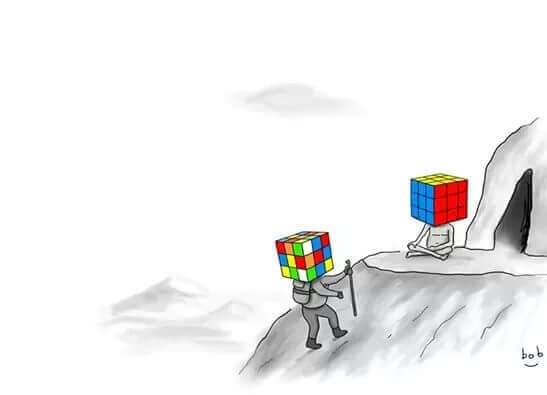Creating Emotional Distance: An Essential Strategy


Written and verified by the psychologist Raquel Aldana
When we constantly have to deal with complicated situations, we learn to give ourselves emotional distance, to manage our distress and think before making a decision. Like with everything else, you need time and experience to learn something like this. A lot of experience.
Creating emotional distance is a strategy that lets us see and feel things a different way. It’s when we give ourselves time for emotions like anger to lose their strength and give way to other feelings. This allows us to more clearly understand what we’re thinking and how we want to act.
In other words, it helps us to better manage our emotions and thus view our opinions and actions more clearly regarding a certain topic, like our attitude towards another person, for example.

What do we have to do to create some emotional distance?
How can we give ourselves emotional distance? There’s no magical recipe, as it depends on many personal, circumstantial, and relationship factors.
We carry some people with us everywhere, right down to our roots, and distancing ourselves from the emotions that they generate in us is one of the most complicated tasks we have to carry out.
Although we don’t have a magical recipe that leads us to emotional distance, we can at least highlight many of the ingredients that we need.
As we already said, it’s necessary to give ourselves time to settle our emotions. Think of a traffic light and how it goes from red, to yellow, to green.

When we’re insulted, the light probably goes from yellow to red. In other words, when we’re overcome with anger, sadness, happiness, or any other emotion, our traffic light is red, and therefore we shouldn’t make any decisions.
When the traffic light is red, we should curb our emotional reaction and give ourselves time to gain control over our thoughts, feelings, and actions.
Observe the situation and distance yourself if necessary, but don’t make any permanent decisions based on temporary emotions, even if you have a strong desire to say a few words to someone, or shout at them and then leave forever. Give yourself time for your emotions to calm; go out and take a walk, color, or let a few days pass before talking to or seeing the person who made you feel angry or sad.
As time passes, things feel less important, and some of the things that made you upset become trivial, circumstantial.
Thanks to the passage of time, we can distance ourselves from the emotional intensity that disappointment, expectations, and betrayal can cause in us. Like every other skill, we can learn to stop being controlled by our emotions through practice.

The inner compass: a benefit of emotional distance
Once you’ve distanced yourself from your emotions, you can listen to your inner compass, which gives you an idea of which decisions are wise and unwise. Those intuitions are often accurate, as they’re based on our values, which are much more durable than our emotions.
Then the decisions you make regarding other people and what happened will be much wiser, or rather more in line with what you think and feel. Then you’ll know what deserves your attention and what you should ignore, which will keep you from suffering so much over emotions that you can’t control.
In summary, it’s very important to create emotional distance from complicated, intense, or stressful situations so that the most fleeting aspects of your emotions don’t interfere and make you do something you’ll regret.
Images courtesy of Claudia Tremblay
When we constantly have to deal with complicated situations, we learn to give ourselves emotional distance, to manage our distress and think before making a decision. Like with everything else, you need time and experience to learn something like this. A lot of experience.
Creating emotional distance is a strategy that lets us see and feel things a different way. It’s when we give ourselves time for emotions like anger to lose their strength and give way to other feelings. This allows us to more clearly understand what we’re thinking and how we want to act.
In other words, it helps us to better manage our emotions and thus view our opinions and actions more clearly regarding a certain topic, like our attitude towards another person, for example.

What do we have to do to create some emotional distance?
How can we give ourselves emotional distance? There’s no magical recipe, as it depends on many personal, circumstantial, and relationship factors.
We carry some people with us everywhere, right down to our roots, and distancing ourselves from the emotions that they generate in us is one of the most complicated tasks we have to carry out.
Although we don’t have a magical recipe that leads us to emotional distance, we can at least highlight many of the ingredients that we need.
As we already said, it’s necessary to give ourselves time to settle our emotions. Think of a traffic light and how it goes from red, to yellow, to green.

When we’re insulted, the light probably goes from yellow to red. In other words, when we’re overcome with anger, sadness, happiness, or any other emotion, our traffic light is red, and therefore we shouldn’t make any decisions.
When the traffic light is red, we should curb our emotional reaction and give ourselves time to gain control over our thoughts, feelings, and actions.
Observe the situation and distance yourself if necessary, but don’t make any permanent decisions based on temporary emotions, even if you have a strong desire to say a few words to someone, or shout at them and then leave forever. Give yourself time for your emotions to calm; go out and take a walk, color, or let a few days pass before talking to or seeing the person who made you feel angry or sad.
As time passes, things feel less important, and some of the things that made you upset become trivial, circumstantial.
Thanks to the passage of time, we can distance ourselves from the emotional intensity that disappointment, expectations, and betrayal can cause in us. Like every other skill, we can learn to stop being controlled by our emotions through practice.

The inner compass: a benefit of emotional distance
Once you’ve distanced yourself from your emotions, you can listen to your inner compass, which gives you an idea of which decisions are wise and unwise. Those intuitions are often accurate, as they’re based on our values, which are much more durable than our emotions.
Then the decisions you make regarding other people and what happened will be much wiser, or rather more in line with what you think and feel. Then you’ll know what deserves your attention and what you should ignore, which will keep you from suffering so much over emotions that you can’t control.
In summary, it’s very important to create emotional distance from complicated, intense, or stressful situations so that the most fleeting aspects of your emotions don’t interfere and make you do something you’ll regret.
Images courtesy of Claudia Tremblay
This text is provided for informational purposes only and does not replace consultation with a professional. If in doubt, consult your specialist.







